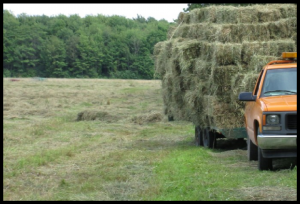 Download a PDF copy of this management sheet:
Download a PDF copy of this management sheet:
Producing Hay for HorsesDownload PDF
The standing joke is that if a hay grower asked 5 different horse owners to describe ideal hay for their horse, he would get at least 6 different answers! A situation that is funny to the uninitiated; frustrating to the hay grower; and somewhat rooted in both fact and myth in the mind of the horse owner. So how does one figure out how to produce hay for horses?
The kind of hay a knowledgeable horseman is looking for will likely depend on the nutrient requirements of their animals as well as the condition of the hay. Generally, moldy, dusty or coarse hay is considered unacceptable for horses. Timely harvest and thorough curing along with dry, ventilated storage will minimize or eliminate condition problems. Very active horses, like race horses, performance horses, work horses and active show animals, require higher levels of both protein and energy than less active horses. Similarly, breeding mares have less digestive volume, but higher requirements during gestation and through lactation. Young, growing animals also have higher protein requirements than more mature animals. These animals are typically fed well-made alfalfa or alfalfa-grass mixed hay. Legumes, such as alfalfa, clover and trefoil, have high-levels of protein when harvested prior to bloom. Grasses, such as timothy, orchardgrass and tall fescue, harvested prior to heading supply highly digestible energy and necessary fiber to the diet. Buyers responsible for obtaining hay for these types of horses tend to be both discriminating and loyal to growers who can consistently provide the top quality hay they require.
 A second group of moderately active horses can be well provided for with well-made grass hay with minimal legume content. Animals that are ridden or trained for less than half a day at a time as well as mature breeding stock, except as noted above, and even more active animals thrive on the energy available in timely harvested and carefully stored grass hay. Hay producers with aging yet productive stands of leafy grasses in which the legume component has faded out can continue to market a very acceptable hay product suited to a broader group of horse operations than high-end legume hay.
A second group of moderately active horses can be well provided for with well-made grass hay with minimal legume content. Animals that are ridden or trained for less than half a day at a time as well as mature breeding stock, except as noted above, and even more active animals thrive on the energy available in timely harvested and carefully stored grass hay. Hay producers with aging yet productive stands of leafy grasses in which the legume component has faded out can continue to market a very acceptable hay product suited to a broader group of horse operations than high-end legume hay.
Perhaps the largest and most varied hay market supplies the owners of ‘backyard’, pleasure horses. Whether these animals are boarded or kept at home, these animals are often minimally active and therefore have lower dietary requirements. If given the opportunity, these animals often eat from boredom, not just need. More mature grass or mixed hay that can be obtained at the lowest possible price is typically adequate nutritionally for these horses. The X-factors in this group are the ailments and allergies (whether real or perceived) of individual animals and the preconceptions and preferences of their owners. In our experience, pleasure horse hay buyers tend to fall into two categories: 1) those who are discriminating about the product and service provided by the grower and less concerned about the price as long as it is a reasonable value; 2) those who are most concerned about the price and give minimal consideration to the condition or nutritional value of the hay.
So how does one produce hay for the equine market? Establish and grow the best possible hay. Learn to harvest timely and properly store dry bales to maintain quality and condition. Work to establish contacts and loyal buyer relationships with individuals in each segment of the horse industry so that regardless of the quality of hay produced in a given year as good a price as possible can be obtained for what you produce. Visit with your local FSM dealer for recommendations about selecting the best grasses and legumes for your farm as well as plant nutrition recommendations and marketing ideas.

